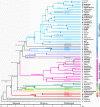A mitochondrial genome phylogeny of voles and lemmings (Rodentia: Arvicolinae): Evolutionary and taxonomic implications
- PMID: 34797834
- PMCID: PMC8604340
- DOI: 10.1371/journal.pone.0248198
A mitochondrial genome phylogeny of voles and lemmings (Rodentia: Arvicolinae): Evolutionary and taxonomic implications
Abstract
Arvicolinae is one of the most impressive placental radiations with over 150 extant and numerous extinct species that emerged since the Miocene in the Northern Hemisphere. The phylogeny of Arvicolinae has been studied intensively for several decades using morphological and genetic methods. Here, we sequenced 30 new mitochondrial genomes to better understand the evolutionary relationships among the major tribes and genera within the subfamily. The phylogenetic and molecular dating analyses based on 11,391 bp concatenated alignment of protein-coding mitochondrial genes confirmed the monophyly of the subfamily. While Bayesian analysis provided a high resolution across the entire tree, Maximum Likelihood tree reconstruction showed weak support for the ordering of divergence and interrelationships of tribal level taxa within the most ancient radiation. Both the interrelationships among tribes Lagurini, Ellobiusini and Arvicolini, comprising the largest radiation and the position of the genus Dinaromys within it also remained unresolved. For the first time complex relationships between genus level taxa within the species-rich tribe Arvicolini received full resolution. Particularly Lemmiscus was robustly placed as sister to the snow voles Chionomys in the tribe Arvicolini in contrast with a long-held belief of its affinity with Lagurini. Molecular dating of the origin of Arvicolinae and early divergences obtained from the mitogenome data were consistent with fossil records. The mtDNA estimates for putative ancestors of the most genera within Arvicolini appeared to be much older than it was previously proposed in paleontological studies.
Conflict of interest statement
The authors have declared that no competing interests exist.
Figures


Similar articles
-
The evolutionary radiation of Arvicolinae rodents (voles and lemmings): relative contribution of nuclear and mitochondrial DNA phylogenies.BMC Evol Biol. 2006 Oct 9;6:80. doi: 10.1186/1471-2148-6-80. BMC Evol Biol. 2006. PMID: 17029633 Free PMC article.
-
[Supraspecies relationships in the subfamily (Rodentia, Cricetidae, Arvicolinae): unexpexted result of nuclear genes analysis].Mol Biol (Mosk). 2009 Sep-Oct;43(5):897-909. Mol Biol (Mosk). 2009. PMID: 19899636 Russian.
-
Molecular phylogeny of the speciose vole genus Microtus (Arvicolinae, Rodentia) inferred from mitochondrial DNA sequences.Mol Phylogenet Evol. 2004 Dec;33(3):647-63. doi: 10.1016/j.ympev.2004.07.015. Mol Phylogenet Evol. 2004. PMID: 15522793
-
Phylogenomics of African radiation of Praomyini (Muridae: Murinae) rodents: First fully resolved phylogeny, evolutionary history and delimitation of extant genera.Mol Phylogenet Evol. 2021 Oct;163:107263. doi: 10.1016/j.ympev.2021.107263. Epub 2021 Jul 14. Mol Phylogenet Evol. 2021. PMID: 34273505 Review.
-
Population cycles and outbreaks of small rodents: ten essential questions we still need to solve.Oecologia. 2021 Mar;195(3):601-622. doi: 10.1007/s00442-020-04810-w. Epub 2020 Dec 28. Oecologia. 2021. PMID: 33369695 Free PMC article. Review.
Cited by
-
Signatures of Adaptation in Mitochondrial Genomes of Palearctic Subterranean Voles (Arvicolinae, Rodentia).Genes (Basel). 2021 Dec 2;12(12):1945. doi: 10.3390/genes12121945. Genes (Basel). 2021. PMID: 34946894 Free PMC article.
-
Ancient DNA of narrow-headed vole reveal common features of the Late Pleistocene population dynamics in cold-adapted small mammals.Proc Biol Sci. 2023 Feb 22;290(1993):20222238. doi: 10.1098/rspb.2022.2238. Epub 2023 Feb 15. Proc Biol Sci. 2023. PMID: 36787794 Free PMC article.
-
Reduced representation approaches produce similar results to whole genome sequencing for some common phylogeographic analyses.PLoS One. 2023 Nov 30;18(11):e0291941. doi: 10.1371/journal.pone.0291941. eCollection 2023. PLoS One. 2023. PMID: 38032899 Free PMC article.
-
First mitochondrial genome of the Amazonian marsh rat Holochilus sciureus Wagner 1842 (Rodentia, Cricetidae, Sigmodontinae).Mitochondrial DNA B Resour. 2022 Aug 29;7(8):1562-1564. doi: 10.1080/23802359.2022.2107956. eCollection 2022. Mitochondrial DNA B Resour. 2022. PMID: 36051366 Free PMC article.
-
The complete mitochondrial genome of Proedromys bedfordi Thomas 1911 (Arvicolinae, Rodentia).Mitochondrial DNA B Resour. 2024 Dec 8;9(12):1653-1657. doi: 10.1080/23802359.2024.2422978. eCollection 2024. Mitochondrial DNA B Resour. 2024. PMID: 39664026 Free PMC article.
References
-
- Musser GG, Carleton MD. Superfamily Muroidea. Mammal species of the world: a taxonomic and geographic reference. JHU Press; 2005. pp. 894–1531.
-
- Pardiñas UFJ, Myers P, León-Paniagua L, Ordóñez Garza N, Cook JA, Kryštufek B, et al. Family Cricetidae (true hamsters, voles, lemmings and new world rats and mice). Handb Mamm World. 2017;7: 204–279.
-
- Lebedev VS, Bannikova AA, Tesakov AS, Abramson NI. Molecular phylogeny of the genus Alticola (Cricetidae, Rodentia) as inferred from the sequence of the cytochrome b gene. Zool Scr. 2007;36: 547–563. doi: 10.1111/j.1463-6409.2007.00300.x - DOI
-
- Buzan EV, Krystufek B, Hänfling B, Hutchinson WF. Mitochondrial phylogeny of Arvicolinae using comprehensive taxonomic sampling yields new insights. Biol J Linn Soc. 2008;94: 825–835. doi: 10.1111/j.1095-8312.2008.01024.x - DOI
Publication types
MeSH terms
Substances
LinkOut - more resources
Full Text Sources

